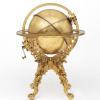Santucci's sphere, Florence, 1588-93
External links
Commentary
Images 1-2
Armillary sphere. Maker: Antonio Santucci, Florence, 1588-1593. Materials: wood, metal. Dimensions: sphere diameter c. 2000 mm, height 3700 mm, width c. 2450 mm. Source: Museo Galileo, Florence (18 October 2013), Inventory no. 714 and Wikimedia Commons (Licence: CC BY 3.0).
Commentary (from the Museo Galileo): ‘Begun on March 4, 1588, and completed on May 6, 1593, this large armillary sphere was built under the supervision of Antonio Santucci at the request of Ferdinand I de' Medici. The sphere represents the "universal machine" of the world according to the concepts developed by Aristotle and perfected by Ptolemy. The terrestrial globe is placed at the center. Surprisingly, it even displays territories that were still relatively little known at the time… The wooden parts of the sphere are elaborately painted and covered with fine gold leaf. The sphere rests on a stand with four sirens, heavily restored in the nineteenth century.’
A video explaining the sphere and animating its motion is available at the Museo Galileo.
Images 3-4
The Florentine sphere resembles a smaller one built by Santucci in 1582 for Philip II of Spain, now in the library of the Escorial. In addition to the image provided by the Museo Galileo, see the following:
Image 3. Photo by Merce, 1 Dec. 2005. CC BY-SA 2.0. Flickr. Image 4. Photo by Jose Luis Filpo Cabana, March 2013. CC 3.0. Wikimedia Commons.


